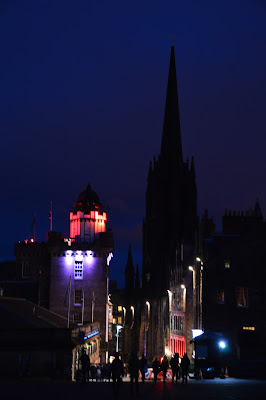Highland Fling
This year our canal related wedding anniversary trip took us to the lovely city of Edinburgh and included a visit to both the Kelpies and the Falkirk Wheel. The weather was a bit dull, cold and very windy but it didn't spoil our visit and even made the impressive sculptures look quite dramatic set against the steel sky.
The Kelpies are the work of sculptor Andy Scott who's vision was to create " a contemporary sculptural monument. Water-borne, towering gateways into The Helix, the Forth & Clyde canal and Scotland, translating the legacy of the area into proud equine guardians."
Inspired by the history of local heavy horse use, particularly the Clydesdale, pulling barges on the Forth & Clyde Canal, wagons, ploughs and coalships combined with the mythological 'kelpie', a transforming beast possessing the strength of a hundred horses.
Fabricated from steel and built on site in just 90 days they are both cutting edge technology and hand crafted artisanship, a tribute to the lost industries of Scotland and a celebration of the bright future the country. The sculptor's father was a Falkirk man, giving the project special significance.
Each Kelpie weighs in at 300 tonnes, is 30 metres high and contains 928 steel plates
The site development included an extension of the Forth & Clyde canal to include an attractive turning pool for boaters and visitor centre. It was really enjoyable and well worth it if you're in the area.
Our next stop was the Falkirk Wheel where we had a boat trip booked to experience the unique rotating boat lift ourselves. Originally the Forth and Clyde and the Union Canals were joined by a staircase flight of eleven locks climbing 35 metres which were dismantled in the 1930's, severing the connection.
During the 1990's several ideas were considered including tilting tanks. The final design is said to have been inspired in part by the Celtic double headed spear. Work started in 1998, being constructed in Derbyshire in parts that were transported by lorry and reassembled on site. Using 1200 tonnes of steel and over 1000 construction staff. The 15,000 bolts used were all tightened by hand! It was officially opened in 2002.
We arrived early enough to see the trip boat ascending before our own trip, enabling us to see the wheel in action from the ground. The wheel works by rotating cog wheels on rails in the larger holes. Powered by hydraulic motors assisted by the weight of the 'caissons' it uses surprising little energy to move. Each water filled caisson works using Archimedes' principle, that floating objects displace their own weight in water, meaning that even when there is only a boat in one, they both weigh the same.
Once the boat is lifted from the Union Canal that reaches from Falkirk to Edinburgh, there are two locks to raise the link by another 11 metres to join the Forth & Clyde Canal that runs from Grangemouth to Glasgow linking the two cities.
The wheel is not built on the exact site of the original locks as this area has since been developed but instead a short distance away. This led to other obstructions to be overcome including building a length of tunnel 'Roughcastle' in a new culvert to link the canals.
The 1:10 scale Kelpies Maquettes are scale models commissioned to raise awareness of both the sculptures and the wheel and have been displayed in various locations from Sheffield to Chicago and even made an appearance in New York during Scotland Week 2014.
The boat trip was really interesting and the view from the top of the wheel on the return journey was good despite the weather.
As with the Kelpies we had a thoroughly enjoyable visit which I would recommend to any canal enthusiast. We returned to the city to enjoy a nice meal out and had a walk up the Royal Mile to the castle which was all lit up. There is a great view from the castle to the lower levels of Edinburgh.
Edinburgh Castle
Looking back down the Royal Mile
Useful information can be found at the sites below:
www.thehelix.co.uk
www.scottishcanals.co.uk/falkirk-wheel
















No comments:
Post a Comment